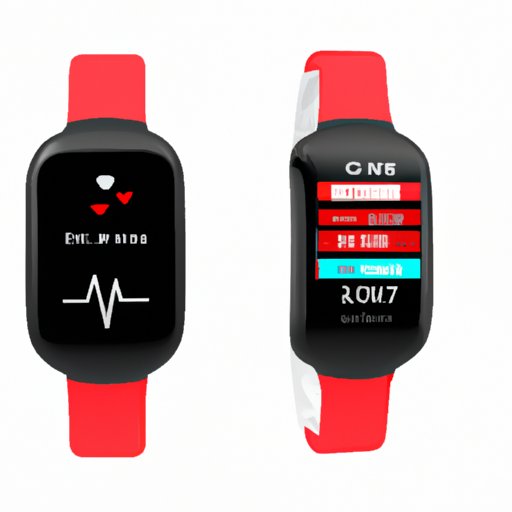
I. Introduction
Checking your pulse is an essential indicator of your general well-being and is important for monitoring your health and fitness. Your pulse rate indicates how many times your heart beats per minute. By knowing your pulse rate, you can detect any underlying health conditions and assess your overall cardiovascular health. In this article, we will discuss five topics that will provide you with a comprehensive guide to checking your pulse like a pro.
II. 5 Simple Steps to Check Your Pulse Like A Pro
Checking your pulse is a simple process that you can perform wherever you are. The first step is to locate your pulse. Place your index and middle fingers on the inside of your wrist, or on the side of your neck, just below the earlobe. Once you locate your pulse, count the beats for 15 seconds, then multiply by four to determine your pulse rate per minute. You can use a stopwatch or timer to count the seconds.
It is essential to note that there are different places to check your pulse rate, such as the wrist, neck, temple, groin, and ankle. We recommend starting with your wrist or neck, where the pulse is easiest to locate. When checking your pulse, pay attention to the rhythm and beat strength. If your pulse is irregular or too weak or strong, it could be an indicator of a health problem.
III. Why Checking Your Pulse Is Important and How To Do It At Home
Monitoring your pulse is especially important for those with specific health conditions, such as high blood pressure, heart disease, or diabetes. It can help your doctor or healthcare provider detect changes that may require treatment or medication. Normal pulse readings range between 60 and 100 beats per minute. However, individual factors, such as age, weight, and activity level, can impact your pulse rate.
You can check your pulse at home by following the same process used by healthcare professionals. You can do this by identifying where your pulse can be measured and counting the number of beats per minute. It is essential to sit down and rest for at least five minutes before taking your pulse rate. This is because physical activity, such as walking up a flight of stairs, can increase your pulse rate and give inaccurate readings.
IV. Find Your Rhythm: How To Check Your Pulse Before and After Exercise
Checking your pulse before and after exercise is a helpful way to track your heart rate and monitor your fitness level. Before exercising, take your pulse rate to establish a baseline reading. A higher pulse rate than usual can signify a change in your health or fitness level and could indicate the need to modify your exercise routine. After exercise, take your pulse rate again to assess your recovery rate. A lower pulse rate after exercise indicates better cardiovascular fitness.
You can check your pulse before and after exercise by using a heart rate monitor, through wearable technology such as a smartwatch or fitness tracker, or manually using the process described in Section II.
V. Know Your Pulse: 3 Tools to Make Checking Your Pulse A Breeze
In addition to manually checking your pulse, there are several pulse measuring tools available in the market, which can make checking your pulse more convenient. These tools include smartwatches, fitness trackers, and digital health monitors.
Smart watches and fitness trackers are wearable technology that provides real-time heart rate measurements, including a host of other features like notifications, call or SMS alerts, etc. Digital health monitors can track various parameters like ECG, PPG, and other vital signs specific to health conditions. By using these tools, you can track your pulse rate and monitor your health more accurately.
VI. Understand Your Health: How To Check Your Pulse For Better Well-being
Your pulse rate is an indicator of your general health, and it’s essential to monitor it regularly. This section aims to provide you with health tips to keep your heart healthy and monitor your pulse rate and rhythm.
It is essential to maintain a healthy lifestyle by engaging in regular physical activity, consuming a balanced diet, maintaining a healthy weight, avoiding smoking and alcohol, and managing stress levels. These lifestyle habits can help keep your heart healthy, maintain a steady pulse rate, and prevent heart problems.
VII. The ABCs of Pulse Checks: A Guide for Beginners
For beginners, pulse checks may seem daunting, but checking your pulse is a necessary skill that you can quickly learn with practice. In this section, we will discuss the fundamentals of pulse checks, including how to locate your pulse and what to look for when monitoring your heart rhythm.
First, locate your pulse by placing your index and middle fingers on the inside of your wrist or neck. Next, count the beats for 15 seconds, then multiply by four to determine your pulse rate per minute. Ensure you sit down and rest for at least five minutes before taking your pulse rate. Finally, pay attention to the rhythm and beat strength, and if your pulse is irregular or too weak or strong, consult your healthcare provider.
VIII. Conclusion
Checking your pulse is a simple but essential process that can provide vital insights into your general health and well-being. In this article, we have discussed five comprehensive topics to help you check your pulse like a pro. These topics cover the basics of checking your pulse, why monitoring your pulse rate is important, the benefits of tracking your heart rate before and after exercise, pulse-measuring tools, and health tips to keep your heart healthy. We encourage you to regularly check your pulse rate and rhythm to monitor your health and fitness level.




